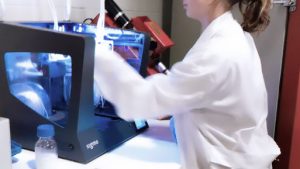Researchers at the University of Girona have successfully isolated stem cells from one of the most aggressive forms of breast cancer – using 3D printing. The goal of isolating the cells is to find a drug that attacks them exclusively, without damaging healthy parts of the body.
 According to Dr. Teresa Puig, Director of the Oncology Unit of the Group for the Investigation of New Therapeutic Targets, these breast cancer cells still remain in the body after treatment via chemotherapy or radiotherapy and often cause relapse. This particular type of cancer is the triple negative subtype, which occurs in young women and leads to relapses in 20 to 30 percent of patients within three or four years.
According to Dr. Teresa Puig, Director of the Oncology Unit of the Group for the Investigation of New Therapeutic Targets, these breast cancer cells still remain in the body after treatment via chemotherapy or radiotherapy and often cause relapse. This particular type of cancer is the triple negative subtype, which occurs in young women and leads to relapses in 20 to 30 percent of patients within three or four years.
“A tumor is made up of many types of cells, and these are the cells we have in low proportions,” said Dr. Puig. “Therefore, it is complicated to locate these cells within the tumor. This new system is cleaner, allowing us to work more directly with these types of cells later.”
The research is documented in a paper entitled “Screening of Additive Manufactured Scaffolds Designs for Triple Negative Breast Cancer 3D Cell
Culture and Stem-Like Expansion.” The main goal of the study was to develop a scaffold architecture that afforded a high breast cancer cell proliferation rate. Several values of the selected parameters, which included layer height, infill density, infill pattern, infill direction, and flow, were tested on the slicing software BCN3D Cura and the scaffolds were 3D printed on the BCN3D Sigma 3D printer.
Using the Taguchi experimental design method, 27 scaffold configurations were manufactured and analyzed. At least 10 copies of each configuration were 3D printed to perform the characterization and cell proliferation assays, with the objective being to see which geometric form was most effective in separating the stem cells.
“This structure is a mesh that, on the basis of a series of parameters such as porosities, spaces, and the distance between one element and another, is ultimately able to allow cells to stick to the matrix or not, to grow, and to be able to ‘enrich themselves’, as our colleagues say,” said Joaquim de Ciurana, Director of the Research Group on the Engineering of Products, Processes, and Production.
Before this research, these cell cultures were produced two-dimensionally, which did not allow the cells to be effectively separated, so specific drugs could not be produced to attack the cells. But the 3D method in which the researchers isolated the stem cells for this study allows them to better study the cells in order to find the bio-indicators responsible for the tumors. They will then be able to attack them with pharmaceuticals, although the research is not yet at that point.
“We still do not know how to treat them, but we have found a way to isolate them,” said Dr. Puig.

Optical microscope images of cells attached to different scaffolds configurations. White arrows indicate cells adhered to PLA filament.
This method is also more cost-effective than traditional analysis methods, allowing for more frequent experiments in the future.
Authors of the paper include Emma Polonio-Alcalá, Marc Rabionet, Antonio J. Guerra, Marc Yeste, Joaquim de Ciurana and Teresa Puig. Several of these scientists were also involved in a recent study about 3D printed composite stents.
Discuss this and other 3D printing topics at 3DPrintBoard.com or share your thoughts below.
[Source/Images: BCN3D Technologies]
Subscribe to Our Email Newsletter
Stay up-to-date on all the latest news from the 3D printing industry and receive information and offers from third party vendors.
You May Also Like
Precision at the Microscale: UK Researchers Advance Medical Devices with BMF’s 3D Printing Tech
University of Nottingham researchers are using Boston Micro Fabrication‘s (BMF) 3D printing technology to develop medical devices that improve compatibility with human tissue. Funded by a UK grant, this project...
3D Printing Webinar and Event Roundup: April 21, 2024
It’s another busy week of webinars and events, starting with Hannover Messe in Germany and continuing with Metalcasting Congress, Chinaplas, TechBlick’s Innovation Festival, and more. Stratasys continues its advanced training...
3D Printing Webinar and Event Roundup: March 17, 2024
It’s another busy week of webinars and events, including SALMED 2024 and AM Forum in Berlin. Stratasys continues its in-person training and is offering two webinars, ASTM is holding a...
3D Printed Micro Antenna is 15% Smaller and 6X Lighter
Horizon Microtechnologies has achieved success in creating a high-frequency D-Band horn antenna through micro 3D printing. However, this achievement did not rely solely on 3D printing; it involved a combination...































